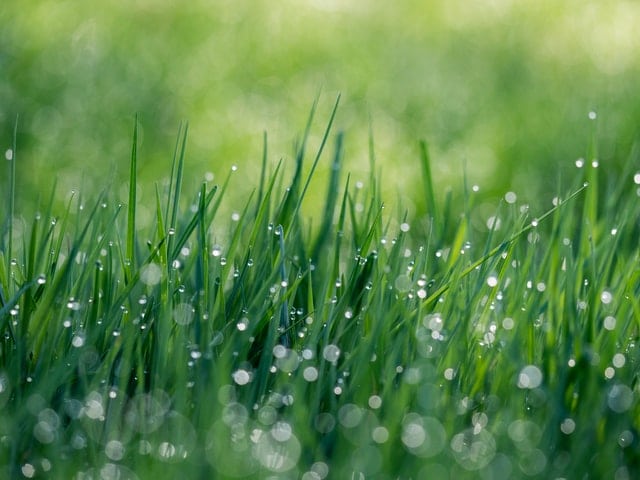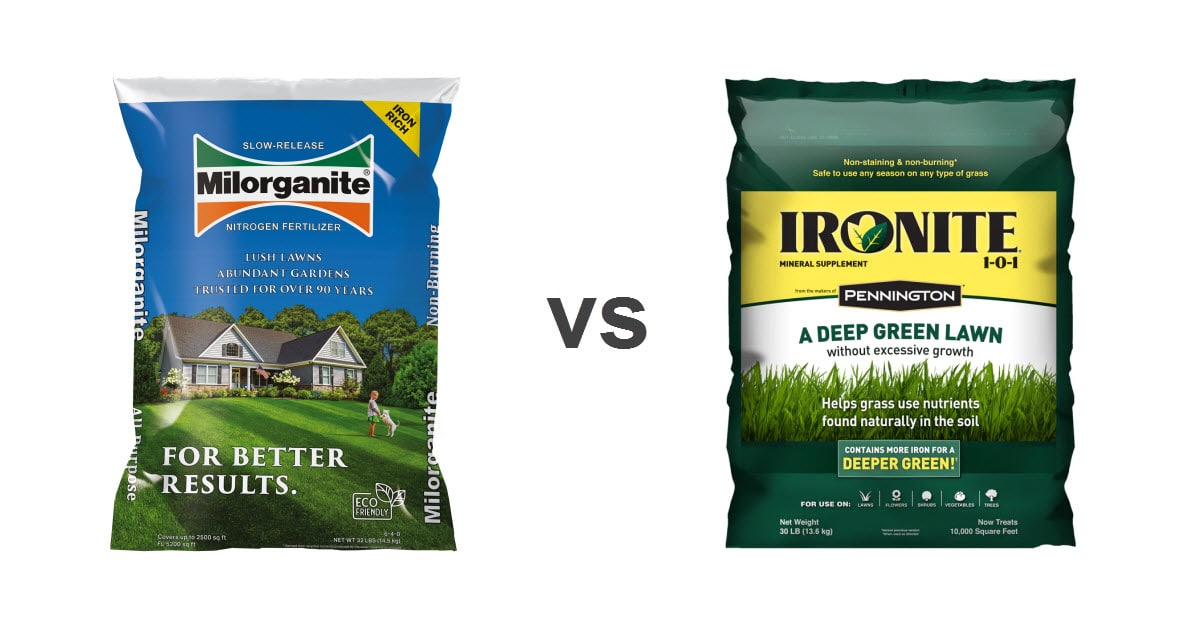A deep green color is a telltale sign of a healthy lawn. And while there are many simple ways to achieve optimal lawn health, water and sunshine may not always be enough. Homeowners often opt for lawn products such as Miligranite or Ironite to achieve healthier, and greener looking lawns. While both products provide lawns with the iron they need to green up, they both work in different ways, have different formula compositions, and serve different purposes. Here, we will compare Milorganite vs Ironite to help you choose the right product for your yard.
Let’s get started!

This article was last updated on by Lawn Chick Owner Sarah Jameson
Article content reviewed for accuracy by Horticulturist Arthur Davidson, A.S.
| LawnChick.com is reader supported. If you make a purchase after clicking a link, I may earn a commission at no additional cost to you. |
Milorganite vs Ironite Comparison
Milorganite and Ironite are each brand-name lawn products.
Each product is manufactured by distinct companies, and each company is focused on lawn care. The difference is that they both target different areas and serve different purposes.
Milorganite

Milwaukee Metropolitan Sewage District manufactures Milorganite.
They specialize in using recycled and composted materials in their fertilizers, in addition to extra supplements and nutrients. Milorganite uses microbes to absorb nutrients from wastewater.
The brand takes pride in their slow-release method. The microbes are placed in the soil and water insoluble nitrogen releases the nutrients over time.
Milorganite penetrates the soil to slowly strengthen roots over time. It’s an organic lawn fertilizer and contains iron, which helps to green up the leaves of grass.
Ironite

Ironite is a brand named lawn supplement that is manufcatured by Pennington Seed Incorporated.
While Milorganite is a fertilizer, Ironite is not. It is a nutrient lawn supplement that is to be used as an additive when you apply lawn fertilizer.
The purpose of Ironite is to “re-green” grass after it has started yellowing. Yellow leaves on any plant (including grass) is typically a sign of an iron deficiency.
While Ironite contains different micronutrients for a healthy lawn, the formula specializes in iron as iron helps boost and synthesizes proteins that aid in photosynthesis and chlorophyll production.
When Ironite is applied to lawns, results can be seen quickly (within days).
One potential drawback to using Ironite, however, is that it can stain concrete, so you have to be very careful when applying it – especially if you use the liquid form.
Milorganite or Ironite – Which Should You Use?
Milorganite and Ironite are both great for lawn care, but serve very different purposes and show different results.
I’ve used both personally on my lawn, and if you need help choosing which product to use on your lawn, I’ve got you covered.
Here is a basic rundown of when to use Milorganite vs Ironite on your grass:
For Greener Lawns
Lawn starting to yellow? Want to regain that dark green color in a hurry?
Ironite is the way to go.

Ironite swears by their fast acting formula which allows homeowners to achieve great, visible results in just weeks (and sometimes days).
This product contains the right amount of concentrated nutrients aside from iron, that enable fast results for greener lawns. Apply Ironite on lawns with a fertilizer between 4-10 times a year for the best results.
In liquid form, Ironite penetrates from the glass blades themselves, in granular form, Ironite works on soil quality so that soil requires less water while the formula works on re-greening your lawn.
For Soil Improved Soil Quality

If you’re looking for a product that will feed your lawn and green up your grass, Milorganite is the better option.
Milorganite does not contain the harsh concentrated metals that Ironite has, and is a more natural way to go (if that’s important to you).
The goal of Milorganite is to improve soil quality through slow-release organic nitrogen. Ironite’s “quick fix” ideology is for people who want results now, and are not necessarily looking for a sustainable solution that will keep their lawn dark green.
Milorganite works with the soil and the needs of the roots in order to slowly release nutrients when needed. Milorganite is a fertilizer and can be used more frequently than Ironite as the ingredients are less harsh and more suitable for prolonged use and long lasting results over time.
For an Eco-Friendly and Sustainable Lawn Solution
While both Ironite and Milorganite provide supplementary nutrients which are beneficial to lawn growth and health, Milorganite is more eco-friendly.
Milorganite consists of microbes that contain recycled nutrients from wastewater. Therefore, the formula is more eco friendly in terms of production and its effects.
However, both Ironite and Milorganite are safe to use on lawns, even if you have pets and kids, and both products guarantee that they do not burn your grass.

You do need to be careful with Ironite and not over-apply, or your grass could start to be almost gray-green. Get the math right with your granules and mix it with a good fertilizer and you’ll be just fine. If you’re using the liquid version of Ironite, I recommend mixing it with a natural dye (I use this one from Amazon) so you can easily see where you’ve applied it to your lawn.
For a Shortage of Nutrients
If your soil has a shortage in nutrients, there are many different ironite formulas available to help you get the results you seek.
Generally, the focus of Ironite is to improve the quality of lawns that have iron deficiencies. However, Ironite is also rich in a number of different micronutrients, and in the right amounts such as soluble nitrogen, which also gives a similar slow release effect as Milorganite.
Different Ironite formulas means that the composition of nutrients come in different ratios.
Aside from iron, Ironite also supplies nitrogen, chlorine, zinc, boron, and copper among other micronutrients.
Final Thoughts on Ironite vs Milorganite for Lawns
Between the two, Ironite and Milorganite serve very different purposes and cannot be compared in terms of which is the better option for all lawns.
Most people want to know whether Milorganite or Ironite will make grass greener.

The answer is they both do that (Ironite rapidly, Milorganite more sustainably over time).
Lawn care is not one size fits all. There are many factors to consider before choosing the products you should be using for your lawn.
Both are easy to use, do not burn, and are good products I’ve used successfully myself.
Do I Use Milorganite and Ironite Today?
I like both products, and have used them both in the past. But do I still use both Ironite and Milorganite on my lawn today?
No.
I use Milorganite 4 times per year on my yard, and I supplement with a different iron supplement called Dr. Iron (Amazon link).
I switched from Ironite to Dr. Iron because it doesn’t stain concrete at all, and my lawn seems to get greener, faster when I use it instead of Ironite.
If you’re after that dark green grass that will make your lawn the envy of the neighborhood, I can recommend a combination of Dr. Iron and Milorganite (though, Ironite will work great instead, and is usually more accessible locally).











6 thoughts on “Milorganite vs Ironite: What are the Differences and Which One to Use”